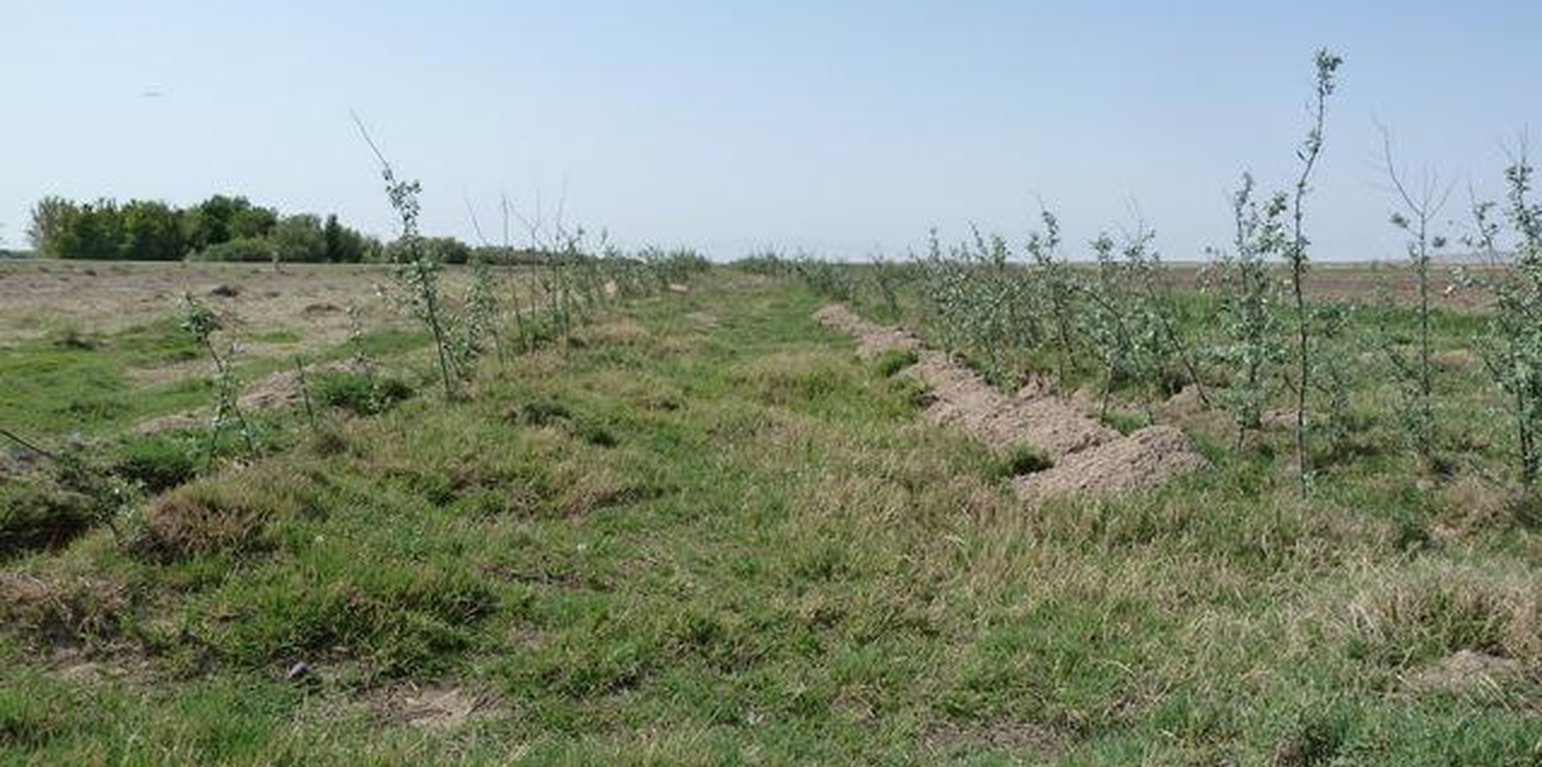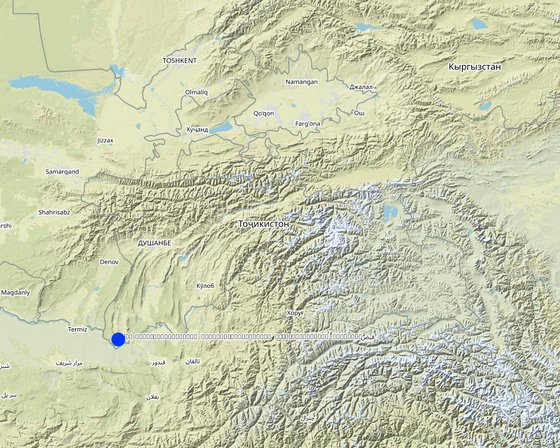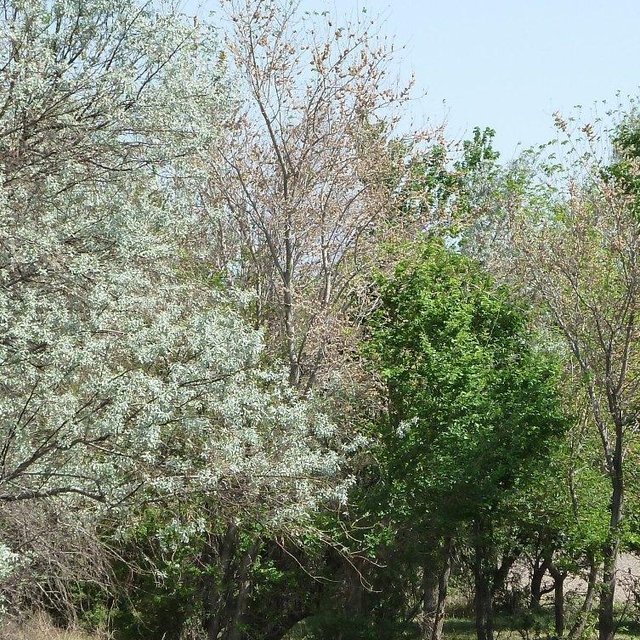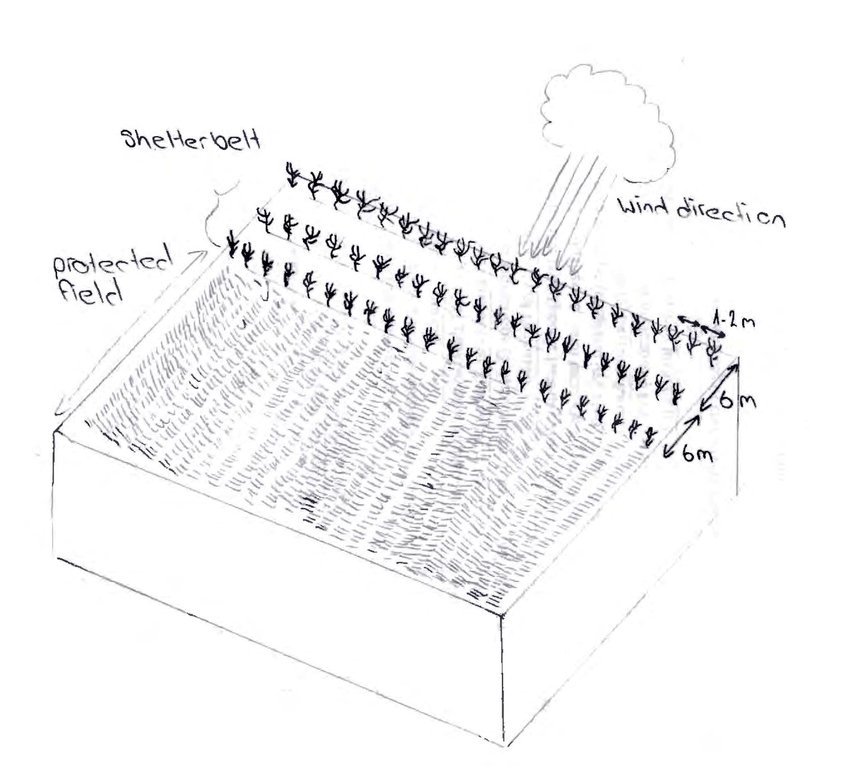



This technology consists of shelterbelts made of Russian Silverberry (Elaeagnus angustifolia) to protect irrigated wheat and rice fields from strong winds.
In the Shaartuz area wind erosion poses huge problems to crop cultivation as topsoil is being removed and deposited as sediments on neighbouring fields. Dusty storms not only damage the crops but they also cause damage to the main surface, the fertile layer of soil. Sand also damages the irrigation canals, roads, gardens and streets in urban areas which forces people to leave such areas. Good yields cannot be achieved if fields are not properly protected.
A solution to this problem is the planting of shelterbelts around fields to slow wind speed and to prevent erosion of the arable soil layer. During Soviet times shelterbelts were planted on collective farms by the state forestry committee under contracts. After the collapse of the USSR and before the formation of Dehkan farms land users were not interested in investing in shelterbelts due to unprotected land use rights and unclear legal procedures. One farmer however tested the planting of a shelterbelt in 1992 when his son came back from his studies at the Agricultural University where he had learnt about the technology. They planted the first shelterbelt using a mixture of different tree species to protect newly irrigated fields. Due to financial constraints they could not invest in any other shelterbelts but in 2010 UNDP provided them with financial support to buy seedlings to increase the shelterbelt area. For this new shelterbelt the native Russian Silverberry (Elaeagnus angustifolia) was considered the most appropriate species as soils were highly saline and only this species proved tolerant.
Trees were planted in three rows, along field boundaries and also along irrigation channels. Within rows trees were spaced at a 1m interval with a 6 m distance between rows. The plantations were established through “haschar” (voluntary neighbourhood help) with 30 people planting about 10,000 trees within one month. During the first three years after planting the saplings need regular irrigation and sanitary cleaning to help establish themselves. After 6-7 years the trees start drawing a lot of water from the soil which prevents the irrigated soils from damage through water logging. Russian silverberry can grow up to 12 m in 10-12 years.
Benefits of these shelterbelts are increased crop yields (wheat and rice) due to the protection from strong winds and decreased evapotranspiration. Thanks to the species association with nitrogen fixing root bacteria soil fertility is improved. The trees further produce edible fruits and provide valuable firewood that is consumed by the households. Russian Silverberry is resistant to pests and diseases and drought-tolerant once established; however, it requires a lot of water during the first few years. One constraint to the establishment of the shelterbelt is local people who often cut down branches for firewood. The farmer therefore has to guard his field whenever possible with the help of his family and staff he has employed to work on his field. Implementation of forestry initiatives began in 2009 and a total of 11 ha land was covered between 2009-2010. 11 farmers were involved in the project and establishment of the shelterbelts was initiated stage by stage during these two years. The project initiatives have also continued into 2011 as well. As other farmers do observe and understand the importance of shelterbelts, there has been a trend towards adoption of the technology by other farmers.

地点: Shaartuz, Khatlon, 塔吉克斯坦
分析的技术场所数量:
技术传播: 均匀地分布在一个区域 (approx. < 0.1 平方千米(10 公顷))
在永久保护区?:
实施日期: 10-50年前
介绍类型






| 对投入进行具体说明 | 单位 | 数量 | 单位成本 (Somoni) | 每项投入的总成本 (Somoni) | 土地使用者承担的成本% |
| 劳动力 | |||||
| labour | ha | 1.0 | 720.0 | 720.0 | 100.0 |
| 植物材料 | |||||
| seedlings | ha | 1.0 | 1350.0 | 1350.0 | |
| 技术建立所需总成本 | 2'070.0 | ||||
| 技术建立总成本,美元 | 460.0 | ||||
| 对投入进行具体说明 | 单位 | 数量 | 单位成本 (Somoni) | 每项投入的总成本 (Somoni) | 土地使用者承担的成本% |
| 劳动力 | |||||
| labour | ha | 1.0 | 85.0 | 85.0 | 100.0 |
| 技术维护所需总成本 | 85.0 | ||||
| 技术维护总成本,美元 | 18.89 | ||||
through increased crop yield
reduced deflation
shelterbelts can provide habitat to birds, insects etc.
from prevention of deposition